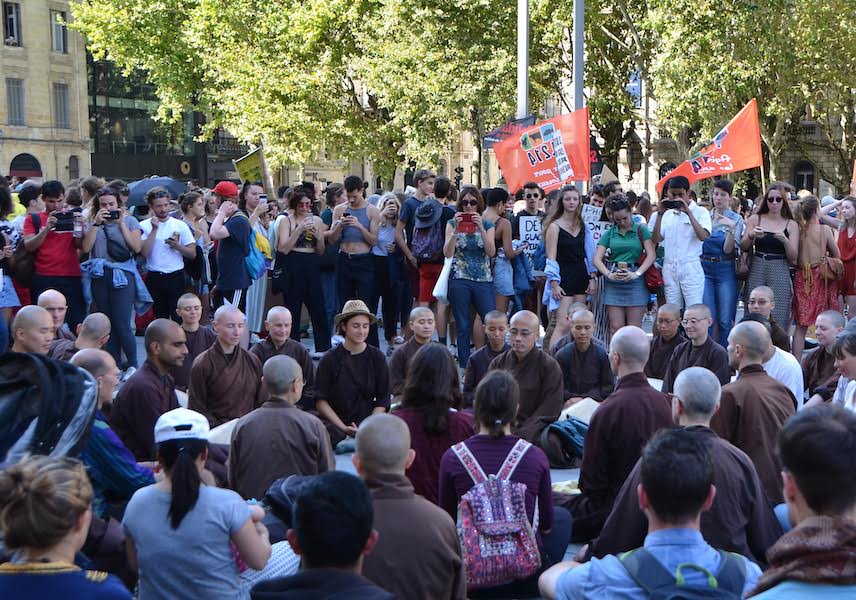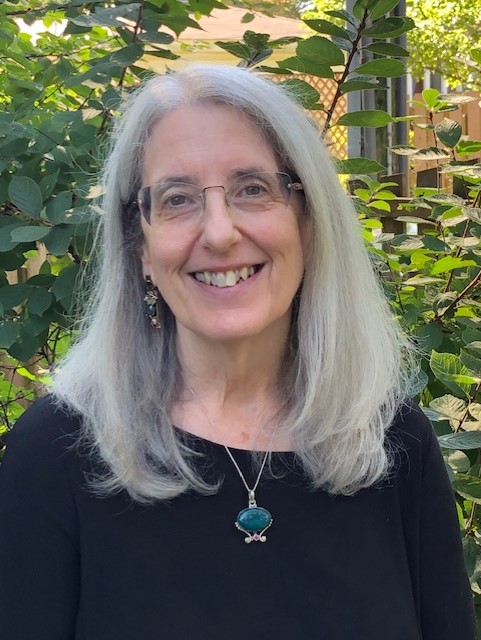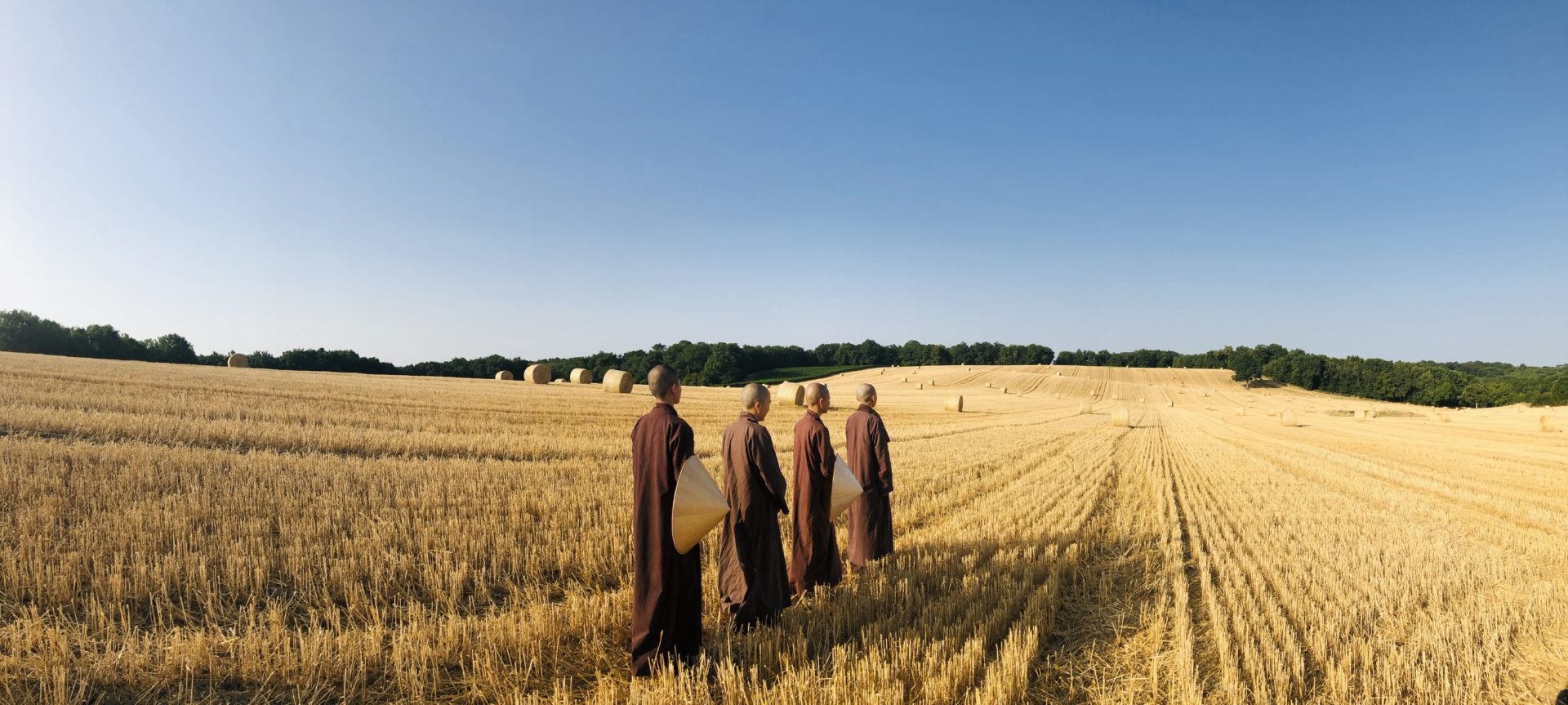By Vicki Seglin

Fierce Compassion Sangha was born of diverse causes and conditions, as all phenomena are. However, the deciding phenomenon was a gentle Dharma prodding delivered in Dharmacarya Trish Thompson’s soft southern accent. She reminded me that the group of three Order of Interbeing aspirants, with whom I met regularly for over two years as part of the mentoring process,
By Vicki Seglin

Fierce Compassion Sangha was born of diverse causes and conditions, as all phenomena are. However, the deciding phenomenon was a gentle Dharma prodding delivered in Dharmacarya Trish Thompson’s soft southern accent. She reminded me that the group of three Order of Interbeing aspirants, with whom I met regularly for over two years as part of the mentoring process, was a valuable study group but not yet truly a Sangha. Perhaps it was time that we became one by opening ourselves to the wider world. I knew, despite a pounding heart and subtle waves of anxiety, that this was indeed the next wise step. Thich Nhat Hanh has said, “Wherever you are, it’s your [Order of Interbeing] duty to set up a group of people practicing.”1
So the four of us, Linda Stevenson (True Legendary Compassion), Diana Gourguechon (True Legendary Condition), Jennifer Howe (True Legendary Harmony), and I, took deep breaths and began the process of creating a new Sangha—another opportunity for practice in the Chicago area. This has provided me with practice and growth opportunities, arising from painful challenges and difficult transitions, that I would not have experienced otherwise.
The first challenge was authorizing ourselves to create this new community. We questioned our abilities to facilitate the growth of a new spiritual community and were concerned about the challenges that would certainly be encountered. Fortunately, for many years I had been a member of the long-established Lakeside Buddha Sangha, skillfully and wisely facilitated by Dharmacaryas Jack and Laurie Lawlor. Unfortunately, due to shifts in my life, the meeting time had become increasingly difficult for me. However, it meant that I came to this new venture equipped with knowledge of a structure and intent that would serve us well.
We drew on our experiences, on Thay’s words, and on Trish’s faith in us. Understanding that a new Sangha at a different day and time would allow for additional practice opportunities, and perhaps be the only opportunity for those who needed a weekday Sangha, also inspired us.
The act of creating the Sangha increased our confidence as we explored Thay’s and the Buddha’s teachings about community, reflected on the Tenth Mindfulness Training, and read Joyfully Together, Friends on the Path, and the Mindfulness Bell articles. We checked in with Order of Interbeing friends around the world as we clarified our own relationships and communication among the four of us.
As a psychologist, one of my areas of expertise is group and organizational dynamics, and this background has been immensely valuable. Groups often start with an idealistic view of each member as well as of the perfection and oneness of the group. Over time, as we gain in experience and intimacy, we realize that although we inter-are, we are not the same, since we hold different opinions and have various levels of practice experience and ideas about Sangha life and structure. This can be invigorating, though if we are not careful and wholehearted in our practice we can find ourselves disappointed or even destabilized.
In working through details of the routines and rituals we would adopt, we asked ourselves: When should we dedicate merit? Will incense bother some people? Who is comfortable with bell minding and how can we support increasing comfort? Who can be sure we are supplied with tea and vegan treats for our break?
In terms of priorities, we asked ourselves: Should we spend more time on the foundational sutras? Are we singing enough? In terms of communications, are we using wise speech? Are we checking in with each other and not making assumptions? For decision-making, we have learned to trust what we already really know; our differences allow us to create a vibrant community using wise speech and deep listening that is richer than any fantasy of total agreement.
Our individual commitments to deep listening, wise speech, and openness of heart have assisted us in navigating the moments when our belief in oneness is rightfully shown to be a comforting but false notion. True growth is occurring in the bumps along the road. In India, I was fortunate to meet with Samdhong Rinpoche, who has held many academic, spiritual, and political appointments in the Tibetan Government in exile. In response to a complaint from another member of our pilgrimage group about the poorly maintained local Indian roads, Rinpoche noted, “Pilgrimages require a bad road.” I have always found that observation immensely comforting; it normalizes the difficulties we will face in our spiritual journeys.
Harmony in the Sangha comes from staying on that bad road, finding room for all the voices, staying open to the unknown, and working toward a consensual decision rather than complete agreement. This involves observing our own feelings since our ideas may not be accepted, or we may not feel listened to, or we simply do not like what is being proposed. We watch our attachment to views about the Sangha and begin to wonder if we are correct.
One major and disturbing and, yes, growth-producing event occurred when we had to tell a member she must leave. This member’s behavior had been troublesome since the start. Initially annoyed, we resolved to use our abilities to listen, observe our reactions, and feel and speak with compassion, as well as reinforce Sangha and practice guidelines. Sadly, these annoyances became severely disruptive and frightening for other Sangha members, to the point that some decided they could not continue if this person remained.
I recognized that I felt immense anxiety when she attended; I was watching carefully to read her mood, trying to see how others were reacting, fearing repercussions if her unstable behavior were to escalate. Recognizing the threat to the Sangha and the responsibility of leadership to protect the group, and mindful that this was not a case of a “scapegoat” absorbing the group’s tensions, we consulted with Dharma teachers, Order of Interbeing members, and monastics. We also studied the booklet on mental health issues published by the North American Dharma Teachers Sangha Caretaking Council.2 The message received universally was that indeed this member, who refused to make any changes in behavior, needed to be told she could no longer attend. This decision was painful, frightening, and necessary.
Through this experience, I learned how often these painful circumstances occurred and how seldom they were discussed. I was not alone in feeling shame and guilt that we had failed in the practice. A deeper practice would have healed this person or allowed us to absorb the feelings, so says the fantasy. I am certainly aware that a Sangha is not a therapy group. Despite this knowledge, the expectations we thought were present about how to use the practice with “difficult people,” along with the silence surrounding these difficult decisions, created indecision for a prolonged period. The expansion of our abilities and willingness to be vulnerable and speak openly to each other about these, and similar, occurrences will be very helpful in our Sangha building.
Future challenges include creating a more diverse Sangha: like others we know of, we are primarily a white, middle-class, liberal, female Sangha. At the moment, we are in agreement on the political climate—and more literally, the climate crisis. How shall we respond if new members arrive who have a distinctly different worldview? We want to explore social justice issues that the Sangha can engage in as a Sangha, not solely as individual practitioners.
We had our first weekend retreat last September, purposefully limited to our core regular attendees so we could ease into this new venture. In the future, we will be opening up Days of Mindfulness and weekends to the larger community. We actively seek out other opportunities to practice at monasteries, and attend local retreats and talks by teachers.
We want to stay open to shifts in the needs of members, while maintaining our basic ritual and routines in order to ground us. Thus, we are planning on a rotating membership of the caretaking council as well as periodic all-Sangha meetings to discuss Sangha issues.
I hope to contribute to an atmosphere that allows us to give each other those gentle Dharma nudges to act as second bodies to each other, supporting each other to see our blind spots and our strengths, and believing we are loved no matter how imperfect we are. Above all, we wish to, as Thay says, “develop the three real powers—understanding, love and cutting through afflictions—to realize collective awakening.” Our name, Fierce Compassion Sangha, was chosen with care and reflects our deepest wish to be peaceful warriors for a compassionate world, starting with ourselves and expanding outward in larger and larger waves.
1 Dharma talk by Thich Nhat Hanh, tnhaudio.org/2017/10/15/create-loving-support-group. August 2001.
2 Mindful Approaches to Behavior and Mental Health Difficulties in Plum Village Sangha Practice, orderofinterbeing.org/wp-content/uploads/2018/04/ Mindful-Approaches.pdf.

Vicki Seglin, True Boundless Compassion, is co-facilitator of Fierce Compassion Sangha in Evanston, Illinois, US. In addition to her work with people as a psychologist, animal liberation is very close to her heart. She is the Chicago Chapter Co-Leader for the international organization Dharma Voices for Animals, and a volunteer at the local animal shelter.

